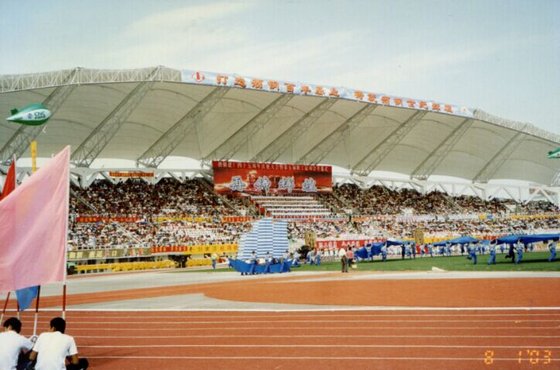
Artificial neural networks and a genetic algorithm were used for optimization, and the PCave of the optimized stadium was improved by 8.96%.

The simulation results were close to real measurements.

The appropriate simulation range was identified, and the test mesh was adjusted. Energy simulations and computational fluid dynamics simulations were performed. The objectives were to reveal the relationship between the stadium's shape and thermal performance with an accurate calculation model and to propose a valid morphological optimization method for improving the thermal-comfort performance. In this paper, the Tianjin Tuanbo tennis stadium was taken as the research object, and the PCave was selected as an evaluation index. This study defined that the PCave is averaged percentage of comfortable seats (UTCI temperature between 9 ☌ and 26 ☌) within one year of use. The main difficulty is the lack of a specific evaluation index for the stadium's thermal comfort and a comprehensive simulation with all the weather conditions in a stadium's use-cycle. Although previous studies provided suggestions, a valid optimization method for improving thermal comfort has not been proposed. Improving the thermal comfort of spectators is an important aspect of the semi-outdoor stadium design procedure. Finally the proposal of the football stadium optimal design strategies are put forward. In this way,the impact mechanism which different canopy forms play on the field wind environment in football stadium is attempted to characterize from the experimental results. Furthermore, the wind field distribution uniformity and wind speed variation stability are taken as the evaluation criterion. And then CFD simulation is carried out on the canopy section profiles and the canopy connection permeability, different external wind speed such as 5 m/s, 10 m/s, 15m/s, flows into the model from east side in all the cases. As for the current developing status of football game in China, a 30,000-capacity medium-sized football stadium model is proposed for research object. STAR-CCM + 9.04.009 is set as simulation platform in this paper. The primary intention of this research is to reveal the relationship between field wind environment and canopy forms based on CFD simulation of wind environment, then construct an optimization design approach of football stadium canopy form. Field wind environment will make a serious impact on players’ performance and game result,while canopy form plays great effect on field wind environment. You would think though that it has been thought out and addressed.After the issue of General Plan of Chinese Football Reform in 2015, the development and construction of football stadium in China was put on an important agenda. The roof of course will protect us from rain/mist/dew. Also, some of the recent vids alluded to the possibility that there will be essentially retractable vent panels in the roof to help release heat.Īs far as cold I'm pretty sure that will be part of the "Outdoor" part of the equation. My understanding is the ETFE panels will block out 60% of the UV rays and I would guess some of the direct heat.

Has anyone come across any information on these matters? I presume the designers thought about and have addressed these issues. On a rainy day, will the stands remain dry, or could crosswinds push the rain under the canopy? And what about runoff? Will it cascade throughout the rim, or funneled to specific points?Īnd what about wind? Will the field be immune, or could the design produce a wind tunnel effect? On a hot day, will the canopy provide shade and reduce the ambient temperature, or will it radiate heat like a greenhouse? AvengerRam wrote:If I understand it correctly, SoFi is essentially an outdoor stadium under a clear canopy.ĭoes that mean it’s not going to be climate controlled?


 0 kommentar(er)
0 kommentar(er)
